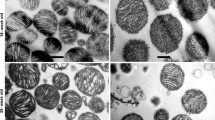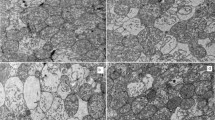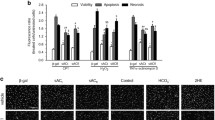Abstract
Mitochondrial Ca2+ plays important roles in the regulation of energy metabolism and cellular Ca2+ homeostasis. In this study, we characterized mitochondrial Ca2+ accumulation in Syrian hamster hearts with hereditary cardiomyopathy (strain BIO 14.6). Exposure of isolated mitochondria from 70 nM to 30 μM Ca2+ ([Ca2+]o) caused a concentration-dependent increase in intramitochondrial Ca2+ concentrations ([Ca2+]m). The [Ca2+]m was significantly lower in cardiomyopathic (CMP) hamsters than in healthy hamsters when [Ca2+]o was higher than 1 μM and a decrease of about 52% was detected at [Ca2+]o of 30 μM (916 ± 67 nM vs 1,932 ± 132 nM in control). A possible mechanism responsible for the decreased mitochondrial Ca2+ uptake in CMP hamsters is the depolarization of mitochondrial membrane potential (Δψ m). Using a tetraphenylphosphonium (TPP+) electrode, the measured Δψ m in failing heart mitochondria was −136 ± 1.5 mV compared with −159 ± 1.3 mV in controls. Analyses of mitochondrial respiratory chain demonstrated a significant impairment of complex I and complex IV activities in failing heart mitochondria. In summary, a less negative Δψ m resulting from defects in the respiratory chain may lead to attenuated mitochondrial Ca2+ accumulation, which in turn may contribute to the depressed energy production and myocardial contractility in this model of heart failure. In addition to other known impairments of ion transport in sarcoplasmic reticulum and plasma membrane, results from this paper on mitochondrial dysfunctions expand our understanding of the molecular mechanisms leading to heart failure.





Similar content being viewed by others
References
Hansford RG, Zorov D (1998) Role of mitochondrial calcium transport in the control of substrate oxidation. Mol Cell Biochem 184:359–369
Balaban RS (2002) Cardiac energy metabolism homeostasis: role of cytosolic calcium. J Mol Cell Cardiol 34:1259–1271
Ohata H, Chacon E, Tesfai SA, Harper IS, Herman B, Lemasters JJ (1998) Mitochondrial Ca2+ transients in cardiac myocytes during the excitation–contraction cycle: effects of pacing and hormonal stimulation. J Bioenerg Biomembr 30:207–222
Wendt-Gallitelli MF, Isenberg G (1991) Total and free myoplasmic calcium during a contraction cycle: X-ray microanalysis in guinea-pig ventricular myocytes. J Physiol 435:349–372
Rizzuto R, Brini M, Murgia M, Pozzan T (1993) Microdomains with high Ca2+ close to IP3-sensitive channels that are sensed by neighboring mitochondria. Science 262:744–747
Sheu SS, Sharma VK (1999) A novel technique for quantitative measurement of free Ca2+ concentration in rat heart mitochondria. J Physiol 518:577–584
Sharma VK, Ramesh V, Franzini-Armstrong C, Sheu SS (2000) Transport of Ca2+ from sarcoplasmic reticulum to mitochondria in rat ventricular myocytes. J Bioenerg Biomembr 32:97–104
Chacon E, Ohata H, Harper IS, Trollinger DR, Herman B, Lemasters JJ (1996) Mitochondrial free calcium transients during excitation–contraction coupling in rabbit cardiac myocytes. FEBS Lett 382:31–36
Gómez AM et al (1997) Defective excitation–contraction coupling in experimental cardiac hypertrophy and heart failure. Science 276:800–806
Eisner DA, Isenberg G, Sipido KR (2003) Normal and pathological excitation–contraction coupling in the heart—an overview. J Physiol 546:3–4
Hobai IA, O’Rourke B (2001) Decreased sarcoplasmic reticulum calcium content is responsible for defective excitation–contraction coupling in canine heart failure. Circulation 103:1577–1584
Ingwall JS, Weiss RG (2004) Is the failing heart energy starved? On using chemical energy to support cardiac function. Circ Res 95:135–145
Ventura-Clapier R, Garnier A, Veksler V (2004) Energy metabolism in heart failure. J Physiol 555:1–13
Jasmin G, Eu HY (1979) Cardiomyopathy of hamster dystrophy. Ann N Y Acad Sci 317:46–58
Di Lisa F, Fan CZ, Gambassi G, Hogue BA, Kudryashova I, Hansford RG (1993) Altered pyruvate dehydrogenase control and mitochondrial free Ca2+ in hearts of cardiomyopathic hamsters. Am J Physiol 264:H2188–H2197
Smith SJ, Augustine GJ (1988) Calcium ions, active zones and synaptic transmitter release. Trends Neurosci 11:458–464
Neher E (1998) Vesicle pools and Ca2+ microdomains: new tools for understanding their roles in neurotransmitter release. Neuron 20:389–399
Homburger F (1979) Myopathy of hamster dystrophy: history and morphologic aspects. Ann N Y Acad Sci 317:1–17
Ward MR (1979) Myopathy of hamster dystrophy: physiologic aspects. Ann N Y Acad Sci 317:18–29
Jasmin G, Proschek L (1982) Hereditary polymyopathy and cardiomyopathy in the Syrian hamster. I. Progression of heart and skeletal muscle lesions in the UM-X7.1 line. Muscle Nerve 5:20–25
Beutner G, Sharma VK, Giovannucci DR, Yule DI, Sheu SS (2001) Identification of a ryanodine receptor in rat heart mitochondria. J Biol Chem 276:21482–21488
Ichas F, Jouaville LS, Mazat JP (1997) Mitochondria are excitable organelles capable of generating and conveying electrical and calcium signals. Cell 89:1145–1153
Grynkiewicz G, Poenie M, Tsien RY (1985) A new generation of Ca2+ indicators with greatly improved fluorescence properties. J Biol Chem 260:3440–3450
Kamo N, Muratsugu M, Hongoh R, Kobatake Y (1979) Membrane potential of mitochondria measured with an electrode sensitive to tetraphenyl phosphonium and relationship between proton electrochemical potential and phosphorylation potential in steady state. J Membr Biol 49:105–121
Birch-Machin MA, Turnbull DM (2001) Assaying mitochondrial respiratory complex activity in mitochondria isolated from human cells and tissues. In: Pon LA, Schon EA (eds) Mitochondria. Academic, San Diego, CA, pp 97–117
O’Gorman E, Beutner G, Dolder M, Koretsky AP, Brdiczka D, Wallimann T (1997) The role of creatine kinase in inhibition of mitochondrial permeability transition. FEBS Lett 414:253–257
Stowell MHB, Wang G, Day MW, Chan SI (1998) Design, synthesis, and photochemical properties of a photoreleasable ubiquinol-2: a novel compound for studying rapid electron-transfer kinetics in ubiquinol-oxidizing enzymes. J Am Chem Soc 120:1657–1664
Srere PA (1969) Citric acid cycle. Methods Enzymol 13:3–11
Bernardi P (1999) Mitochondrial transport of cations: channels, exchangers, and permeability transition. Physiol Rev 79:1127–1155
Sen LY, O’Neill M, Marsh JD, Smith TW (1990) Myocyte structure, function, and calcium kinetics in the cardiomyopathic hamster heart. Am J Physiol 259:H1533–H1543
Rossner KL (1991) Calcium current in congestive heart failure of hamster cardiomyopathy. Am J Physiol 260:H1179–H1186
Krüger C, Erdmann E, Nabauer M, Beuckelmann DJ (1994) Intracellular calcium handling in isolated ventricular myocytes from cardiomyopathic hamsters (strain BIO 14.6) with congestive heart failure. Cell Calcium 16:500–508
Markiewicz W, Wu SS, Parmley WW, Higgins CB, Sievers R, James TL, Wikman-Coffelt J, Jasmin G (1986) Evaluation of the hereditary Syrian hamster cardiomyopathy by 31P nuclear magnetic resonance spectroscopy: improvement after acute verapamil therapy. Circ Res 59:597–604
Seguchi H, Ritter M, Shizukuishi M, Ishida H, Chokoh G, Nakazawa H, Spitzer KW, Barry WH (2005) Propagation of Ca2+ release in cardiac myocytes: role of mitochondria. Cell Calcium 38:1–9
Sánchez JA, Garcia MC, Sharma VK, Young KC, Matlib MA, Sheu SS (2001) Mitochondria regulate inactivation of l-type Ca2+ channels in rat heart. J Physiol 536:387–396
Murphy AN, Bredesen DE, Cortopassi G, Wang E, Fiskum G (1996) Bcl-2 potentiates the maximal calcium uptake capacity of neural cell mitochondria. Proc Natl Acad Sci U S A 93:9893–9898
Panagia V, Lee SL, Singh A, Pierce GN, Jasmin G, Dhalla NS (1986) Impairment of mitochondrial and sarcoplasmic reticular functions during the development of heart failure in cardiomyopathic (UM-X7.1) hamsters. Can J Cardiol 2:236–247
Gunter TE, Pfeiffer DR (1990) Mechanisms by which mitochondria transport calcium. Am J Physiol 258:C755–C786
Nicholls DG (ed) (1982) Bioenergetics: an introduction to the chemiosmotic theory. Academic, London, pp 1–190
Murphy E (2004) Primary and secondary signaling pathways in early preconditioning that converge on the mitochondria to produce cardioprotection. Circ Res 94:7–16
Csordas G, Thomas AP, Hajnóczky G (2001) Calcium signal transmission between ryanodine receptors and mitochondria in cardiac muscle. Trends Cardiovasc Med 11:269–275
Acknowledgements
This work was supported by NIH grants HL-33333 and American Heart Association/New York State Affiliate Grant-in-aid 0050839T. We thank everyone in Dr. Sheu’s laboratory and Dr. Paul Brookes and Dr.Robert Dirksen for helpful discussion on the manuscript.
Author information
Authors and Affiliations
Corresponding author
Rights and permissions
About this article
Cite this article
Lin, L., Sharma, V.K. & Sheu, SS. Mechanisms of reduced mitochondrial Ca2+ accumulation in failing hamster heart. Pflugers Arch - Eur J Physiol 454, 395–402 (2007). https://doi.org/10.1007/s00424-007-0257-8
Received:
Accepted:
Published:
Issue Date:
DOI: https://doi.org/10.1007/s00424-007-0257-8




